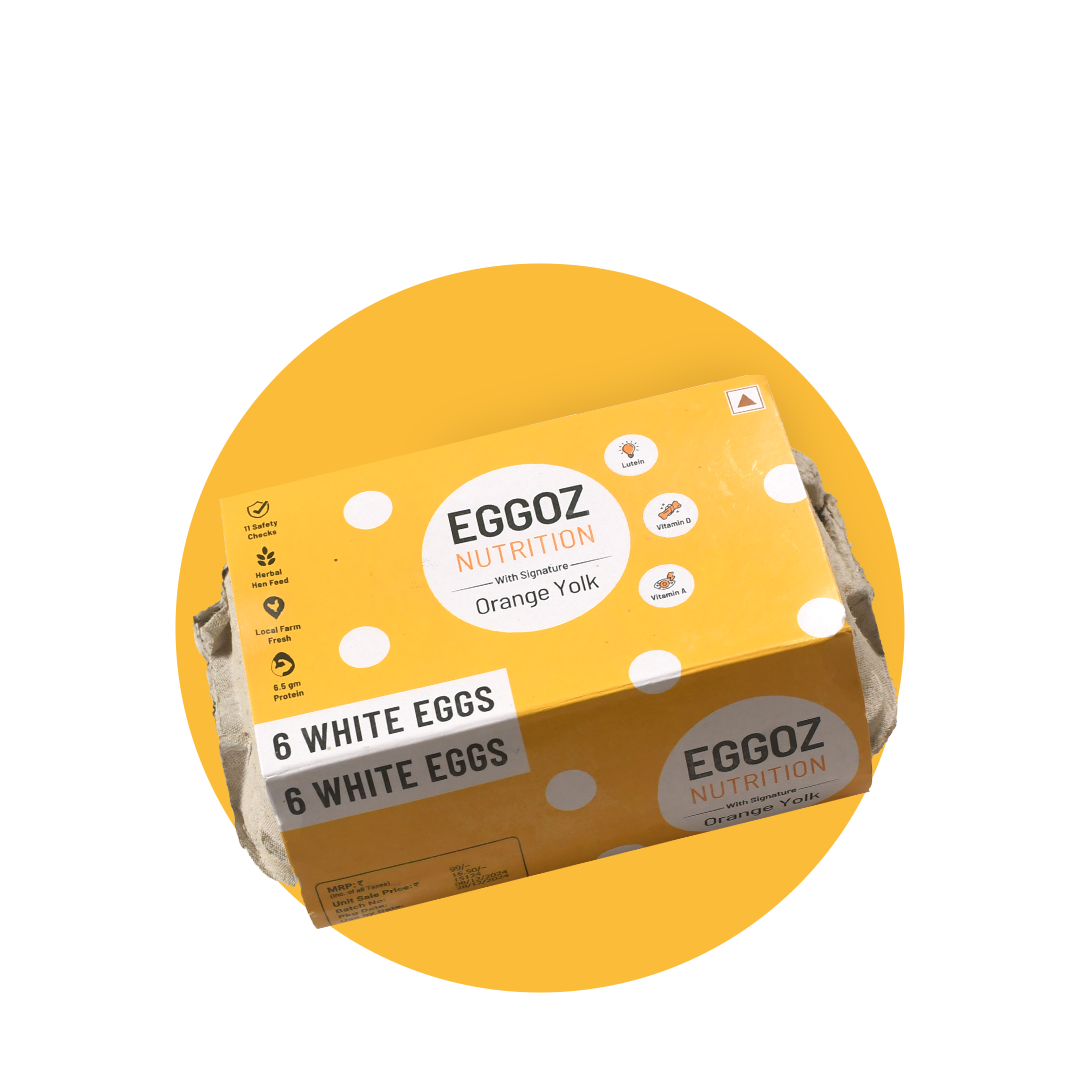Have you ever cracked open an egg, expecting to see a bright yolk but instead found something unusual? Well, you might have encountered a fake egg, a bizarre but real phenomenon in today's market. These artificial wonders, mostly referred to as 'plastic fake eggs', are made to look astonishingly similar to real eggs, but they're not the same.
Now, you might be wondering, why should we care? Well, the best-quality eggs typically feature orange yolks, a sign of a hen's rich, varied diet. Real eggs are packed with nutrients and are a staple in many diets, while these imposters might not be as wholesome.
Whether you buy eggs online or from any nearby retail stores, being able to tell the difference between the two is crucial for your health and your breakfast's integrity.
So, this blog will go through an egg-citing journey to crack the case of fake egg vs real eggs.
Significance of Real Eggs
Original eggs are just like Eggoz eggs that ensure quality and safety, undergoing stringent checks to ensure the highest standards unlike fake eggs. With a comprehensive 11-point safety inspection akin to Eggoz's rigorous process, including cleaning, candling, UV sanitization, and grading, these eggs are a testament to meticulous care. Considering fake egg vs real eggs, real eggs are nutritional powerhouses, each one brimming with essential nutrients having:
- Protein: It contains 6 grams of high-quality protein, which is vital for muscle repair and growth.
- Omega-3 fatty acids: It also contains about 5 grams of healthy fats, including omega-3 fatty acids and choline, beneficial for heart and brain health.
- Vitamins and minerals: Vitamins such as Vitamin D, crucial for bone health and immune function, and B vitamins, vital for energy production and brain health, are abundant in eggs. Plus, the lutein and zeaxanthin found in egg yolks are powerful nutrients for eye health.
With all these nutrients packed into a single, versatile ingredient, real eggs are a nutritional treasure trove, beneficial for every aspect of your health.
Understanding Fake Eggs: How They Are Made and Why?
The creation of a fake egg is a fascinating process that begins with chemicals like gelatin and various additives such as sodium alginate, a substance derived from seaweed. It's mixed with water until it gets a look and feel like real egg white - kind of white and see-through. It reaches a consistency similar to real egg white - slightly white, transparent, and viscous. This concoction forms the base of the 'egg white.'
For the 'yolk,' a portion of this liquid is separated and mixed with lemon-yellow food colouring. The depth of colour is adjusted to mimic that of a natural egg yolk, thus creating the prototype of the 'yolk.' This liquid is then poured into a yolk-shaped mould. To solidify, calcium chloride dissolved in water is added. This reaction rapidly forms a transparent layer around the 'yolk,' solidifying it within a minute.
Once the 'yolk' is formed, it's placed into the 'egg white.' Sealing the shell completes the process of egg creation which is made entirely from raw materials and chemicals. The rationale behind producing these plastic eggs is primarily economic. The production is cost-effective and efficient, making it a lucrative option for manufacturers looking to profit in markets where the demand for eggs is high.
Fake Eggs Side Effects
Consuming plastic fake eggs, which are artificially constructed using a variety of chemicals and non-food materials, poses several health risks that should not be underestimated. Unlike real eggs, which are a natural source of protein, vitamins, and minerals, plastic eggs lack nutritional value. They are primarily made from substances like gelatin, alginate, and artificial colours and additives. The health risks associated with these ingredients are a major concern.
Firstly, the chemicals used in the production of plastic eggs can be harmful if ingested. Regular consumption of these substances may lead to digestive issues, allergic reactions, and long-term health problems. Moreover, fake eggs do not provide the essential nutrients found in real eggs, leading to nutritional deficiencies if they are consumed as a direct replacement. This could lead to gastrointestinal issues, including nausea, vomiting, and diarrhoea.
Effective 5 Ways to Distinguish the Difference Between Fake Eggs and Real Eggs:

Identifying a fake egg from a real one is an essential skill in today's market, where food authenticity is a growing concern. With a few simple tests and keen observation, you can easily differentiate between the two. Let's break down this process into a step-by-step guide to know how to identify fake eggs from real ones.
Visual Inspection: Appearance Differences
Whether you buy the first step in identifying a fake egg is through visual inspection. Real eggs come in various shades, ranging from white to brown, depending on the breed of the hen. These colours are not uniformly distributed and can have natural variations. In contrast, plastic fake eggs often have a bit shinier appearance, and this shininess tends to be more uniform across the egg, which is a giveaway. The shape of real eggs can vary slightly – they are generally oval, with one end slightly rounder than the other. Fake eggs, however, tend to have a more consistent shape, lacking the natural diversity found in real eggs.
Textural Differences
The next step is to feel the texture of the egg. A real egg's shell is slightly rough with visible pores and minor imperfections like bumps or uneven areas. These characteristics are a result of the natural egg-laying process. On the other hand, the shell of a fake egg feels a bit rougher and may lack the natural porosity of a real egg's shell. The difference might be subtle but becomes noticeable with careful observation.
Water Test: Behaviour in Water
Real and plastic fake eggs behave differently in water. To perform this test, gently place the egg in a bowl of water. Real eggs usually sink and lie flat on their sides, while fake eggs might float or behave unnaturally in water. This test is based on the principle that real eggs have a certain density and air cell size that causes them to sink, while the materials used in fake eggs may alter these properties.
Shake Test: Identifying Unusual Sounds
Another effective method is the shake test. Hold the egg close to your ear and gently shake it. Real eggs typically only make a sound if they are old and the yolk has loosened. In contrast, shaking a fake egg might produce a noticeable sound due to the movement of liquid inside, as water overflows from the solid agent used in making the fake egg.
Cracking the Egg: Observing Yolk and Whites
Finally, the most telling test is to crack the egg open. In a real egg, the yolk and egg white are distinct components. The yolk sits centrally in the viscous egg white, which is naturally cloudy and thick. When you crack open a fake egg, shortly after opening, the egg yolk and egg white will tend to melt together. This is because, in fake eggs, both components are made from similar raw materials and lack the natural structure of real egg contents.
Additionally, when frying a real egg, the yolk stays relatively intact unless disturbed. In the case of a fake egg, the yolk tends to spread out easily, even without being touched. This difference is due to the artificial substances used to mimic the yolk and white in fake eggs.
Differentiation Using Tables to Provide a Comprehensive View.
| Aspect | Real Egg | Fake Egg | Identification Tips |
| Shell Colour | Varies from white to brown; colour is not uniform. | A bit shinier, but the difference is subtle. | Look for uniform shininess in plastic fake eggs; real eggs have natural colour variations. |
| Shell Texture | Slightly rough, with visible pores. | Feels rougher than a real egg, and may lack visible pores. | Feel for texture and porosity; real eggshells are subtly rough with tiny pores. |
| Yolk | Natural orange yolk separated from egg white | Mixed with egg white due to its adding chemicals. | Check whether both egg whites and egg yolk are naturally separated. |
| Shape | Generally oval; shape varies slightly. | More uniformly shaped. | Check for variations; each real egg is uniquely shaped. |
| Sound When Shaken | Typically silent unless very old. | Makes noise due to internal liquid movement. | Shake gently; listen for liquid sounds in fake eggs. |
| Smell | Has a natural, faint smell (like raw meat). | No distinct smell. | Smell the egg; real eggs have a subtle, natural odour. |
| Sound When Tapped | Produces a crisp, clear sound. | Less crisp sound compared to real eggs. | Tap gently; real eggs have a distinctive crisp sound. |
| Cooking Behaviour | Yolk stays intact when fried unless disturbed. | Yolk spreads easily without being touched. | Fry and observe; the yolk of fake eggs spreads more readily. |
| Weight and Balance | Slight weight variations; one end may be heavier. | More balanced and uniform in weight. | Weigh and balance; real eggs vary in weight and balance. |
| Shelf Life | Have a limited shelf life and require refrigeration. | It may have a longer shelf life outside refrigeration. | Consider shelf life; real eggs spoil faster and need refrigeration. |
| Nutrition | Packed with Protein, Vitamins and Minerals | Lack of natural nutrition due to use of chemicals and substances. | Buy eggs from reliable sources only. |
Conclusion:
Understanding the difference between real and fake eggs is crucial in today's market. Real eggs are a rich source of essential vitamins and minerals. While fake eggs, made from chemicals and artificial materials, lack these vital nutrients. Original eggs contain bright orange yolk like Eggoz eggs that reflect a natural, diverse diet of the hens, often including ingredients like marigolds and green plants, which enriches both the colour and nutritional value of these eggs. The tests and comparisons distinguish real eggs from real eggs, ensuring that the eggs on your plate are not only genuine but also nutritious. 🥚🌟✨
FAQs
How often should eggs be included in a diet?
Eggs can be eaten daily as part of a balanced diet. However, individual dietary needs vary, so it's recommended to consult with a healthcare professional or a nutritionist for personalised advice.
Are brown eggs nutritionally different from white eggs?
Nutritionally, brown and white eggs are almost identical. The colour difference is due to the breed of the hen and does not significantly affect the nutritional content.
How can I avoid buying plastic eggs?
To avoid buying plastic eggs, purchase eggs from reputable sources such as Eggoz Nutrition. These eggs undergo 11 safety checks and come from hens fed a herbal diet, ensuring high quality, safety, and enhanced nutritional value compared to regular eggs.


